Intercultural
Communication
Intercultural communication is a
discipline that
studies communication across
different cultures and social groups,
or how culture affects
communication. It is used to
describe the wide range of
communication processes and
problems that naturally appear
within an organization or social
context made up of individuals
from different religious, social,
ethnic, and educational
backgrounds.
Kaifaqu Campus, Dalian University of Technology
Autumn, 2020
�
Contents
Lecture 1
How to make a power-point presentation
Lecture 2
Intercultural competence
Lecture 3
Interpersonal communication skills
Lecture 4
Intercultural communication skills
Lecture 5
High-context and low-context cultures
Lecture 6
Linguistic differences via translation
lectures 7 & 8
Nonverbal communication
Lecture 9
Culture shock
Lecture 10
Barriers to Intercultural Communication
Lecture 11
Principles and strategies of intercultural communication
Appendix 1: Scoring Rubric for Group Presentations
Appendix 2: Topic area for PPT Presentation
�
Intercultural Communication 1: Lecture 1 How to Make a Power-Point Presentation
Lecture 1
How to Make a Power-Point Presentation
Top Tips for Effective Presentations
1. Show your Passion and Connect with your Audience
It’s hard to be relaxed and be yourself when you’re nervous. But time and again,
the great presenters say that the most important thing is to connect with your
audience, and the best way to do that is to let your passion for the subject shine
through.
ü Be honest with the audience about what is important to you and why it matters.
ü Be enthusiastic and honest, and the audience will respond.
Your presentation needs to be built around what your audience is going to get
out of the presentation.
As you prepare the presentation, you always need to bear in mind what the
audience needs and wants to know, not what you can tell them.
While you’re giving the presentation, you also need to remain focused on your
audience’s response, and react to that.
You need to make it easy for your audience to understand and respond.
When planning your presentation, you should always keep in mind the question:
ü What is the key message (or three key points) for my audience to take away?
You should be able to communicate that key message very briefly.
3. Keep it Simple: Concentrate on your Core Message
2. Focus on your Audience’s Needs
�
4. Smile and Make Eye Contact with your Audience
Intercultural Communication 1: Lecture 1 How to Make a Power-Point Presentation
Some experts recommend a 30-second ‘elevator summary’, others that you can
write it on the back of a business card, or say it in no more than 15 words.
Whichever rule you choose, the important thing is to keep your core message
focused and brief. And if what you are planning to say doesn’t contribute to that core
message, don’t say it.
This sounds very easy, but a surprisingly large number of presenters fail to do it.
If you smile and make eye contact, you are building rapport, which helps the audience
to connect with you and your subject. It also helps you to feel less nervous, because
you are talking to individuals, not to a great mass of unknown people. To help you with
this, make sure that you don’t turn down all the lights so that only the slide screen is
visible. Your audience needs to see you as well as your slides.
The beginning of your presentation is crucial. You need to grab your audience’s
attention and hold it. They will give you a few minutes’ grace in which to entertain
them, before they start to switch off if you’re dull. So don’t waste that on explaining
who you are. Start by entertaining them.
Try a story (see tip 7 below), or an attention-grabbing (but useful) image on a
slide.
This is a tip from Guy Kawasaki of Apple. He suggests that slideshows should:
ü Contain no more than 10 slides;
ü Last no more than 20 minutes; and
ü Use a font size of no less than 30 point.
This last is particularly important as it stops you trying to put too much
information on any one slide. This whole approach avoids the dreaded ‘Death by
PowerPoint’.
As a general rule, slides should be the sideshow to you, the presenter. A good set
6. Remember the 10-20-30 Rule for Slideshows
5. Start Strongly
�
7. Tell Stories
Intercultural Communication 1: Lecture 1 How to Make a Power-Point Presentation
of slides should be no use without the presenter, and they should definitely contain
less, rather than more, information, expressed simply.
If you need to provide more information, create a bespoke handout and give it
out after your presentation.
Human beings are programmed to respond to stories. Stories help us to pay
attention, and also to remember things. If you can use stories in your presentation,
your audience is more likely to engage and to remember your points afterwards. It is
a good idea to start with a story, but there is a wider point too: you need your
presentation to act like a story.
Think about what story you are trying to tell your audience, and create your
presentation to tell it.
To effectively tell a story, focus on using at least one of the two most basic
storytelling mechanics in your presentation:
Focusing On Characters – People have stories; things, data, and objects do not. So
ask yourself “who” is directly involved in your topic that you can use as the focal
point of your story.
For example, instead of talking about cars (your company’s products), you could
focus on specific characters like:
A Changing Dynamic – A story needs something to change along the way. So ask
yourself “What is not as it should be?” and answer with what you are going to do
about it (or what you did about it).
For example,
The drivers the car is intended for – people looking for speed and adventure
The engineers who went out of their way to design the most cost-effective car
imaginable
Finding The Story Behind Your Presentation
ü
Ø
Ø
ü
Ø Did hazardous road conditions inspire you to build a rugged, all-terrain jeep that
any family could afford?
Ø Did a complicated and confusing food labelling system lead you to establish a color-
coded nutritional index so that anybody could easily understand it?
�
8. Use your Voice Effectively
9. Use your Body Too
Intercultural Communication 1: Lecture 1 How to Make a Power-Point Presentation
The spoken word is actually a pretty inefficient means of communication,
because it uses only one of your audience’s five senses. That’s why presenters tend to
use visual aids, too. But you can help to make the spoken word better by using your
voice effectively.
Varying the speed at which you talk, and emphasizing changes in pitch and tone
all help to make your voice more interesting and hold your audience’s attention.
It has been estimated that more than three quarters of communication is non-
verbal.
That means that as well as your tone of voice, your body language is crucial to
getting your message across. Make sure that you are giving the right messages: body
language to avoid includes crossed arms, hands held behind your back or in your
pockets, and pacing the stage.
Make your gestures open and confident, and move naturally around the stage,
and among the audience too, if possible.
If you find presenting difficult, it can be hard to be calm and relaxed about doing
it.
One option is to start by concentrating on your breathing. Slow it down, and make
sure that you’re breathing fully. Make sure that you continue to pause for breath
occasionally during your presentation too.
If you can bring yourself to relax, you will almost certainly present better. If you
can actually start to enjoy yourself, your audience will respond to that, and engage
better. Your presentations will improve exponentially, and so will your confidence. It’s
well worth a try.
The above are some common rules for an effective presentation. And there are
the four dimensions for a distinctive, effective and polished PowerPoint
10. Relax, Breathe and Enjoy
�
ü
ü
Content
Intercultural Communication 1: Lecture 1 How to Make a Power-Point Presentation
presentation. They are
content,
language,
ü design and
ü delivery.
A well-designed presentation makes ideas flow in a logical manner. It can be
either persuasive or informative.
The structure of a good presentation is to start broad, get specific and end
broad.
You start from a big question, then narrow down to a specific topic, build your
arguments with evidence, eventually end with a conclusion that back up the big
question.
The WOW statement to hook the audience within the first 30 seconds. Once you
make it, the audience is yours.
Here are two most-commonly-used techniques for an opening WOW statement:
1. Tell a story: story telling is a powerful technique to connect your audience in a
memorable and meaningful way. The story could be personal, unexpected,
challenging or funny. Capturing the audience’s attention with a funny story or a
compelling question sets the tone for a more productive presentation. But, be
careful, not to tell a long story. Finish your story in 30 seconds.
Inspire with a quote: quotes are so popular because they are succinct nuggets
of wisdom that can be easily read, remembered, and repeated for instant
inspiration. Most people love quotes.
3. Besides a good structure and an opening WOW statement, the 3rd key for
How to write the opening?
2.
�
Language
Intercultural Communication 1: Lecture 1 How to Make a Power-Point Presentation
persuasive content is repetition. In a presentation, your key messages should be
repeated throughout. Effective presenters use repetition to ensure their key
messages are remembered, and if you need to, refer back to earlier stages of the
presentation to ensure that the audience has fully assimilated your information.
So, repeat the key messages, and you’ll be far more successful at achieving your
objectives. Repeat the key words. repeat, repeat!
The language for a compelling presentation is the S&S language.
1. keep your language simple. The technical jargon that the audience is not
familiar with will make you lose your audience in seconds. So, keep your vocabulary
simple, and get your point across in as straightforward a way as possible. No jargon,
no abbreviation.
2. use signposts to attract the audience in your story. Good presenters always
use language which shows where they are in their presentation. These “signposts” or
sentence patterns make it easier for the audience to follow you, understand you and
get you.
These signpost phrases and sentences can be grouped according to their function
in the presentation:
ü how to welcome,
§ Good morning and welcome to [name of company, name of conference
hall, hotel, etc.].
§ Thank you all very much for coming today.
I hope you all had a pleasant journey here today.
ü how to introduce yourself,
§ My name is Mark Watson and I am responsible for … .
§
�
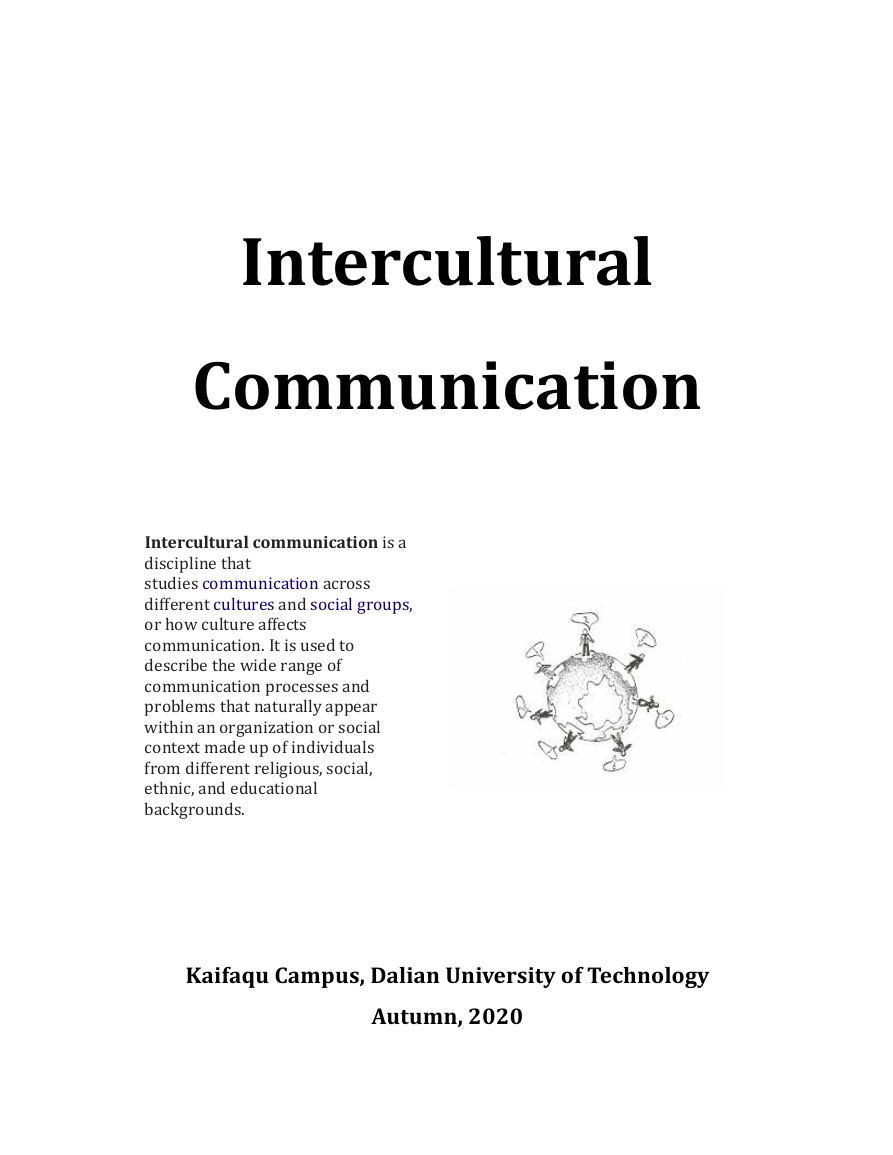
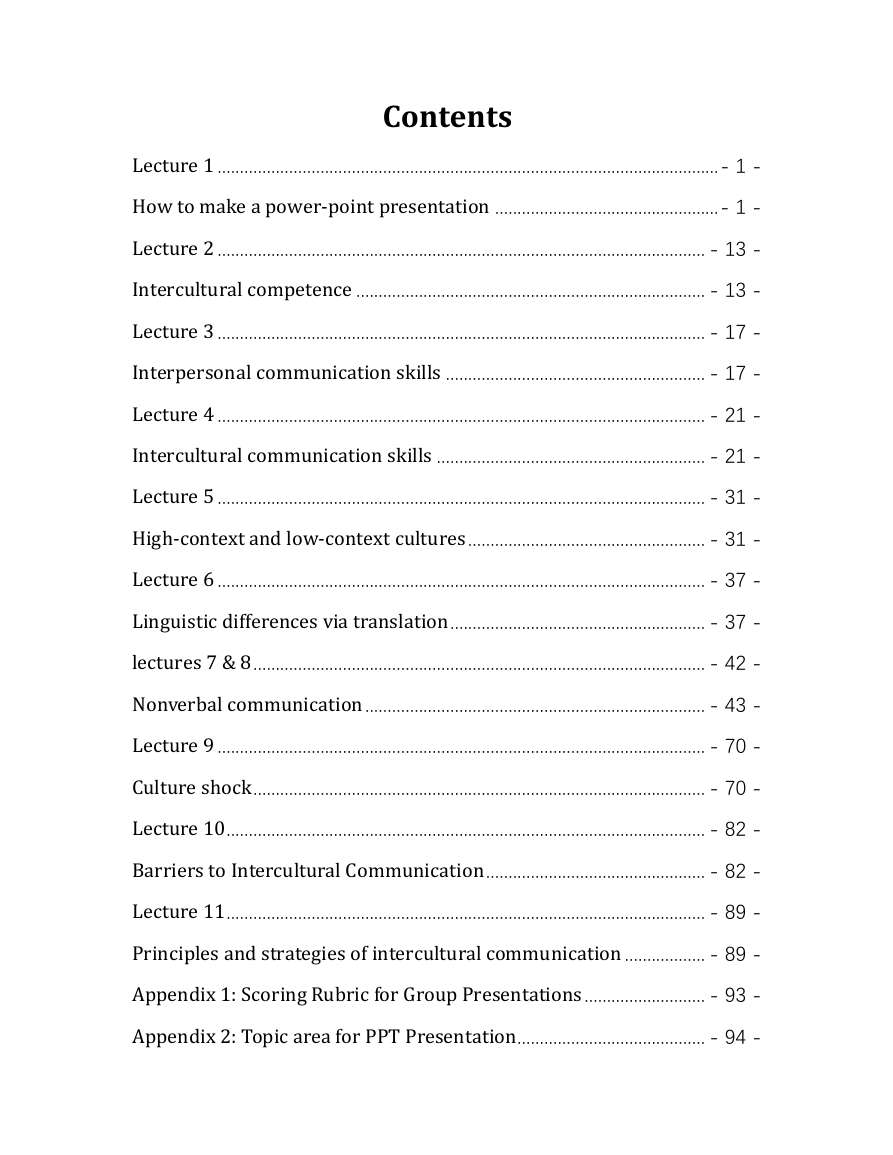


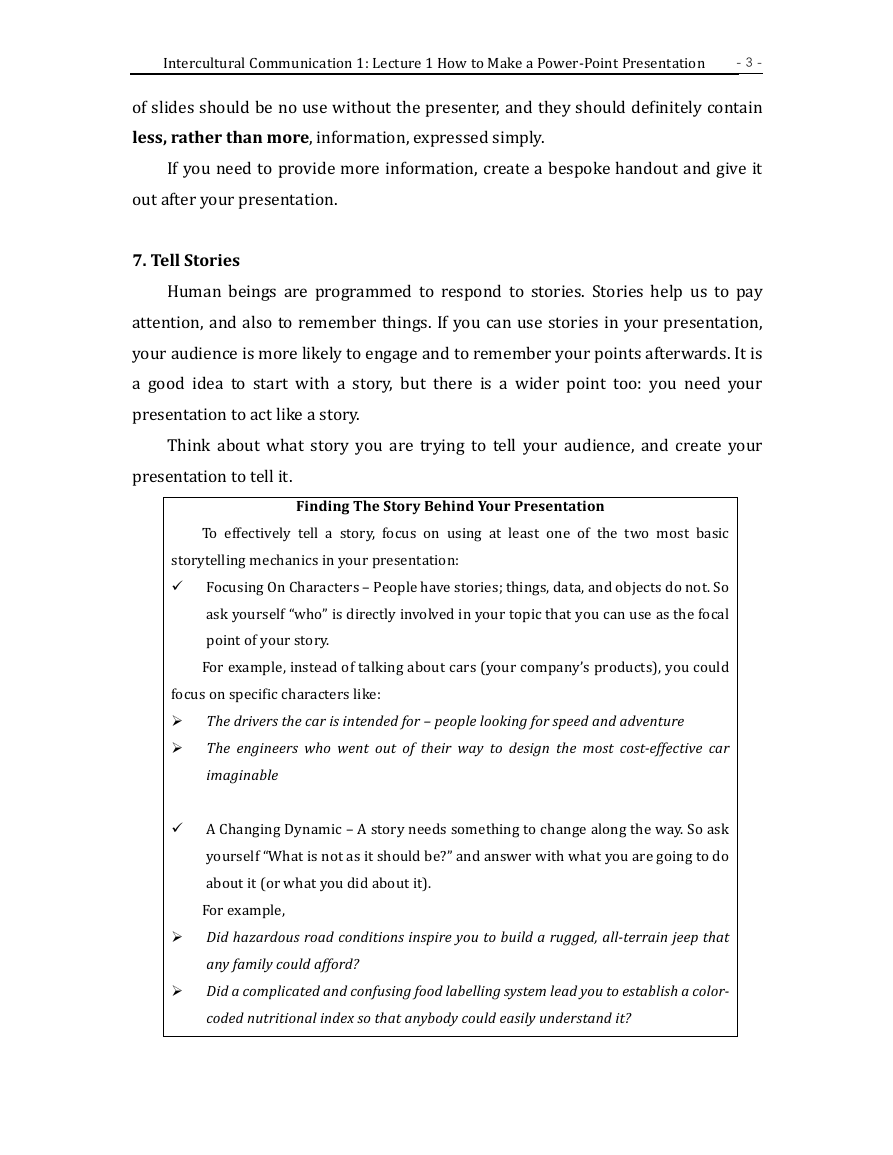
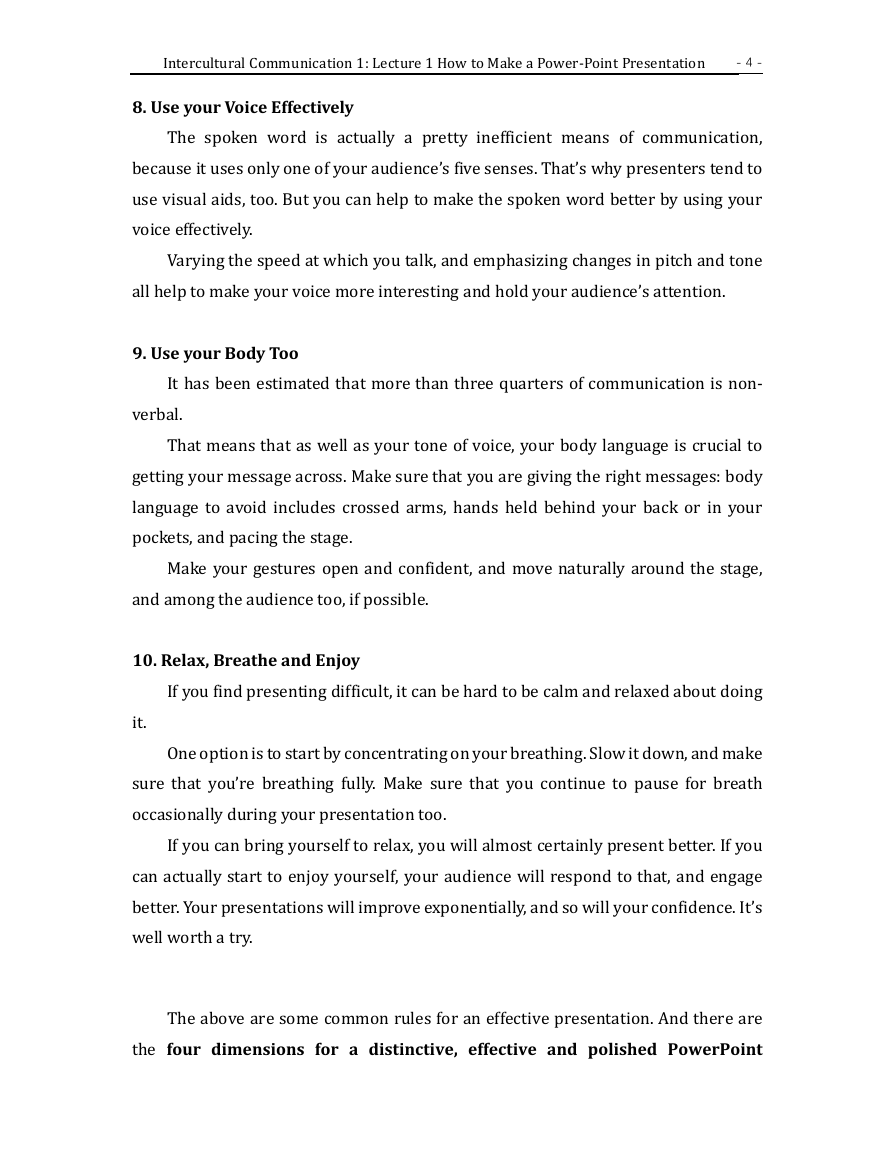
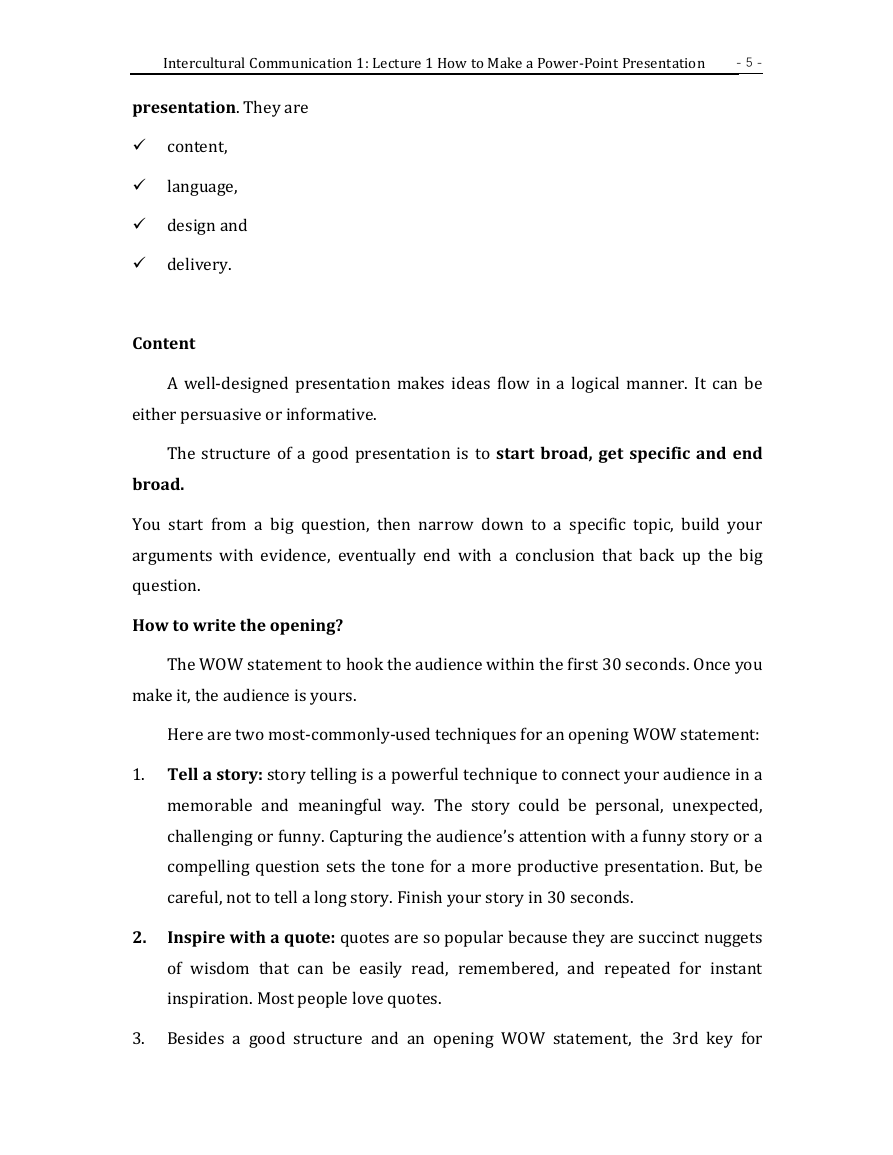
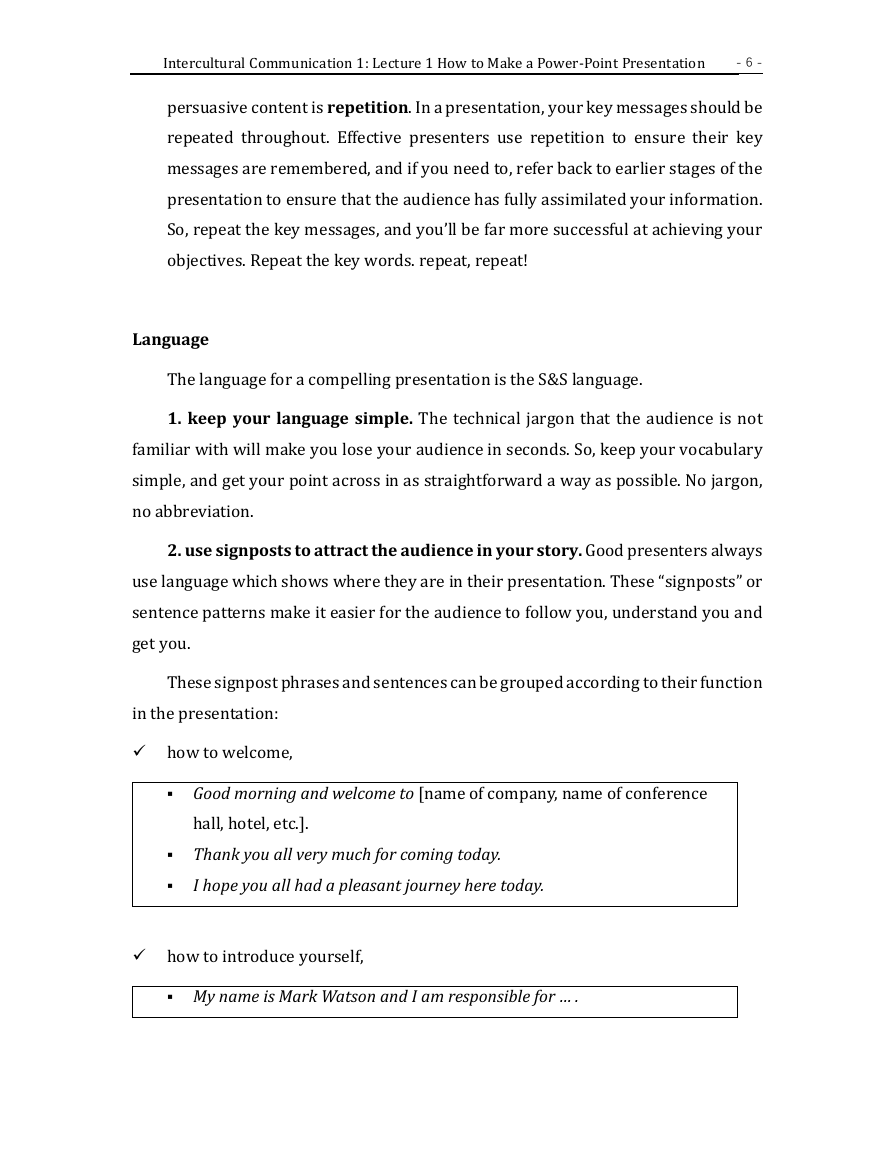








 2023年江西萍乡中考道德与法治真题及答案.doc
2023年江西萍乡中考道德与法治真题及答案.doc 2012年重庆南川中考生物真题及答案.doc
2012年重庆南川中考生物真题及答案.doc 2013年江西师范大学地理学综合及文艺理论基础考研真题.doc
2013年江西师范大学地理学综合及文艺理论基础考研真题.doc 2020年四川甘孜小升初语文真题及答案I卷.doc
2020年四川甘孜小升初语文真题及答案I卷.doc 2020年注册岩土工程师专业基础考试真题及答案.doc
2020年注册岩土工程师专业基础考试真题及答案.doc 2023-2024学年福建省厦门市九年级上学期数学月考试题及答案.doc
2023-2024学年福建省厦门市九年级上学期数学月考试题及答案.doc 2021-2022学年辽宁省沈阳市大东区九年级上学期语文期末试题及答案.doc
2021-2022学年辽宁省沈阳市大东区九年级上学期语文期末试题及答案.doc 2022-2023学年北京东城区初三第一学期物理期末试卷及答案.doc
2022-2023学年北京东城区初三第一学期物理期末试卷及答案.doc 2018上半年江西教师资格初中地理学科知识与教学能力真题及答案.doc
2018上半年江西教师资格初中地理学科知识与教学能力真题及答案.doc 2012年河北国家公务员申论考试真题及答案-省级.doc
2012年河北国家公务员申论考试真题及答案-省级.doc 2020-2021学年江苏省扬州市江都区邵樊片九年级上学期数学第一次质量检测试题及答案.doc
2020-2021学年江苏省扬州市江都区邵樊片九年级上学期数学第一次质量检测试题及答案.doc 2022下半年黑龙江教师资格证中学综合素质真题及答案.doc
2022下半年黑龙江教师资格证中学综合素质真题及答案.doc